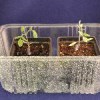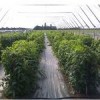 Although Best Management Practices (BMPs) have been developed to reduce the loss of nutrients, like P, to the environment, limited information exists on the main factors that control P loss to Florida groundwater. For example, while it is generally accepted that both irrigation and fertilizer P impact groundwater P, growers often ask if controlling one is more advantageous than the other in their efforts to reduce P leaching. There exists no easy tool to link fertilizer P input and other factors to groundwater P concentration. This 5-page fact sheet uses long-term data (six growing seasons) from a farm in Immokalee, Florida, to explain the effects of soil and agronomic factors, along with seasonal rainfall, on groundwater P. From these factors are derived simple equations to predict groundwater P concentrations. Written by Sanjay Shukla, Gregory S. Hendricks, Thomas A. Obreza, and Willie Harris, and published by the UF Department of Agricultural and Biological Engineering, August 2014.
Although Best Management Practices (BMPs) have been developed to reduce the loss of nutrients, like P, to the environment, limited information exists on the main factors that control P loss to Florida groundwater. For example, while it is generally accepted that both irrigation and fertilizer P impact groundwater P, growers often ask if controlling one is more advantageous than the other in their efforts to reduce P leaching. There exists no easy tool to link fertilizer P input and other factors to groundwater P concentration. This 5-page fact sheet uses long-term data (six growing seasons) from a farm in Immokalee, Florida, to explain the effects of soil and agronomic factors, along with seasonal rainfall, on groundwater P. From these factors are derived simple equations to predict groundwater P concentrations. Written by Sanjay Shukla, Gregory S. Hendricks, Thomas A. Obreza, and Willie Harris, and published by the UF Department of Agricultural and Biological Engineering, August 2014.
http://edis.ifas.ufl.edu/ae507
Tag: Cultural Practices for Vegetables
Healing Chamber for Grafted Vegetable Seedlings in Florida
 Grafting is a horticultural technology that combines two plants, the scion and the rootsock, to create a plant with desirable features from both parts. In the United States the use of vegetable grafting in field production remains limited, although 70% of the total hydroponic greenhouse tomato area uses grafted seedlings. Large, commercial grafting operations use controlled-environment growth chambers, but the high cost limits their use in most small-scale grafting operations. Healing chambers are an alternative solution that provides proper healing at a lower cost for growers and researchers. This 5-page fact sheet was written by Monica Ozores-Hampton and Aline Coelho Frasca, and published by the UF Department of Horticultural Sciences, October 2013.
Grafting is a horticultural technology that combines two plants, the scion and the rootsock, to create a plant with desirable features from both parts. In the United States the use of vegetable grafting in field production remains limited, although 70% of the total hydroponic greenhouse tomato area uses grafted seedlings. Large, commercial grafting operations use controlled-environment growth chambers, but the high cost limits their use in most small-scale grafting operations. Healing chambers are an alternative solution that provides proper healing at a lower cost for growers and researchers. This 5-page fact sheet was written by Monica Ozores-Hampton and Aline Coelho Frasca, and published by the UF Department of Horticultural Sciences, October 2013.
http://edis.ifas.ufl.edu/hs1232
Protected Culture for Vegetable and Small Fruit Crops: The Soilless Trench System (HS1204)
 Vegetable and small fruit crop production under protective structures, such as greenhouses, high tunnels, and shade houses, often requires using soilless media to mitigate the impact of soilborne diseases, nematodes, and weeds, and it helps with management of fertilization and irrigation. Regardless of the nature and property of the media, they need to be held in containers to avoid direct contact with the soil or to elevate plants above the ground. An alternative to purchasing containers is building a soilless trench system for production of certain vegetables and small fruit crops. This 3-page fact sheet was written by Bielinski M. Santos and Teresa P. Salame-Donoso, and published by the UF Department of Horticultural Sciences, August 2012.
Vegetable and small fruit crop production under protective structures, such as greenhouses, high tunnels, and shade houses, often requires using soilless media to mitigate the impact of soilborne diseases, nematodes, and weeds, and it helps with management of fertilization and irrigation. Regardless of the nature and property of the media, they need to be held in containers to avoid direct contact with the soil or to elevate plants above the ground. An alternative to purchasing containers is building a soilless trench system for production of certain vegetables and small fruit crops. This 3-page fact sheet was written by Bielinski M. Santos and Teresa P. Salame-Donoso, and published by the UF Department of Horticultural Sciences, August 2012.
http://edis.ifas.ufl.edu/hs1204
HS1186 Solutions for Small Farmers and Home Gardens: Building a Low-Cost Vertical Soilless System for Production of Small Vegetable and Fruit Crops
HS1186, a 5-page illustrated fact sheet by Bielinski M. Santos, Teresa P. Salame-Donoso, and Shawn C. Arango, provides written and graphic instructions on how to build a homemade vertical soilless (hydroponic) growing system (also known as “bottle grow”) to produce vegetables and small fruit crops at a fraction of the cost of commercially available systems, without occupying premium agricultural land and by utilizing materials available in the home and local hardware store. Published by the UF Department of Horticultural Sciences, November 2010.
http://edis.ifas.ufl.edu/hs1186